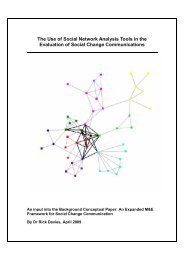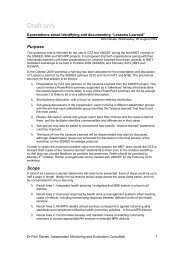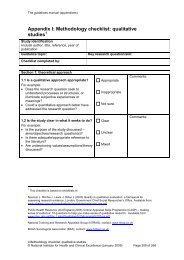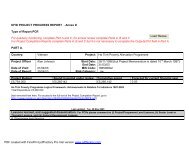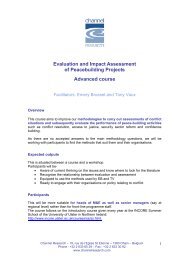Measuring Up: Facilitators guide - Monitoring and Evaluation NEWS
Measuring Up: Facilitators guide - Monitoring and Evaluation NEWS
Measuring Up: Facilitators guide - Monitoring and Evaluation NEWS
Create successful ePaper yourself
Turn your PDF publications into a flip-book with our unique Google optimized e-Paper software.
DAY THREEActivity example output: (continued)What evaluation questions would be informativefor this advocacy work?● Were the government officials/policeauthority representatives invited to roundtablediscussions/training <strong>and</strong> targeted withcoalition messages well selected to affect thenecessary change?● How effective has the coalition been in itsmessage development <strong>and</strong> targeting forgovernment officials <strong>and</strong> the police authority?● Has the coalition been able to contribute toincreased political will to support improvedaccess to harm reduction services <strong>and</strong>policies or legislation that supports this? If so,how? If not, why not?● Has the coalition been able to contribute toimproved policies or legislation that supportsthis improved access to harm reductionservices? If so, how? If not, why not?● To what extent has the coalition’s mediacampaign contributed to progress to improveaccess to harm reduction services?What approach to measurement do you thinkwould be appropriate for this advocacy work?Approach A: identification <strong>and</strong> measurement ofcore outcome areas related to social or policychange.What key indicators will allow you to measurethe results of this advocacy work?● Number of civil society organisationstargeted to join the advocacy coalition.● Percentage of civil society organisationstargeted to join the advocacy coalition thathave joined the coalition.● Number <strong>and</strong> type of organisations that havejoined the coalition.● Number of incidences that collation keymessages are used favourably in the media.● Number of incidences that collationkey messages are used favourably bygovernment officials.● Improved political will of government officialsto improve access <strong>and</strong> reduce barriers toharm reduction services for those that needthem.● Number of policy proposal documentsaccepted for consideration by governmentauthorities.● Increased position of harm reduction servicesfor people who use drugs on the policyagenda for HIV prevention.What are some sources <strong>and</strong>/or means of datacollection for these indicators?The following data collection methods can beused:● Policymaker rating to assess increase inpolitical will for selected government officials(data collection every three months).● Bellwether methodology to determine theplacement of harm reduction on the policyagenda for HIV prevention (data collectionevery six months).● Use of a systems map to identifyrelationships between government officials,police authorities, service providers <strong>and</strong> thepublic in terms of the barriers to access ofharm reduction services.● Media monitoring for inclusion of coalitionmessages in the media.● Media monitoring, meeting observationchecklist <strong>and</strong> review of documentationof parliamentary committee proceedingsto identify use of coalition messages bygovernment officials.What challenges do you anticipate?● Turnover of government officials.● Opposition to messaging from counterlobbyinggroups.● Gaining access to decision-makers within thegovernment <strong>and</strong> police authority.● Number of training events/round tablesfor government officials/police authoritiesprovided on the issue.● Number of government officials/policeauthority representatives attending roundtable discussions/training events on the issue.33 MEASURING UP \\ A GUIDE FOR FACILITATORS



